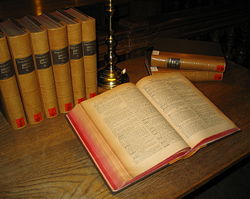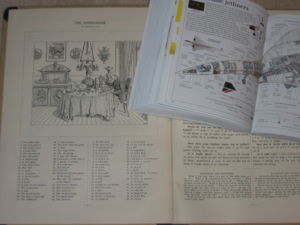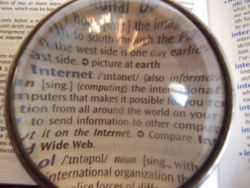Dictionary
2008/9 Schools Wikipedia Selection. Related subjects: Literature types
A dictionary is a book of alphabetically listed words in a specific language, with good definitions, etymologies, pronunciations, and other information; or a book of alphabetically listed words in one language with their equivalents in another, also known as a lexicon.
In many languages, words can appear in many different forms, but only the undeclined or unconjugated form appears as the headword in most dictionaries. Dictionaries are most commonly found in the form of a book, but some newer dictionaries, like StarDict and the New Oxford American Dictionary on Mac OS X, are dictionary software running on PDAs or computers. There are also many online dictionaries accessible via the Internet.
History
The first dictionary of the Chinese language, the Shuowen Jiezi, was written around 100 CE. According to the The Chronicles of Japan, Japanese dictionaries originated in 682 CE, although the first dictionary dealt with the deciphering of Chinese characters. The first dictionary ever written was done by the Babylonians in 6th Century B.C.
The earliest dictionaries were bilingual dictionaries. These were glossaries of French, Italian or Latin words, along with definitions of the foreign words in English. An early nonalphabetical list of 8000 English words was the Elementarie created by Richard Mulcaster in 1582.
The first purely English alphabetical dictionary was A Table Alphabeticall, written by English schoolteacher Robert Cawdrey in 1604.
However, alphabetical ordering continued to be rare until the 18th century. Before alphabetical listings, dictionaries were organized by topic, i.e. a list of animals all together in one topic.
In literary and fanciful usage, multiple dictionaries are referred to as a 'flock of dictionaries'.
Word order
Today, dictionaries of most languages with alphabetic and syllabic writing systems list words in lexicographic order, usually alphabetical or some analogous phonetic system.
In many languages, words are grouped together according to their root word, with the roots being arranged alphabetically. If English dictionaries were arranged like this, the words "import," "export," "support," "report," "porter," "important" and "transportation" would theoretically be listed under the Latin "portare," "to carry." This method has the advantage that all words of a common origin are listed together, but the disadvantage is that one has to know the roots of the word before one can look it up. Some Hebrew, Sanskrit, and Arabic dictionaries work this way.
While most of Japanese and Korean dictionaries are arranged according to their phonetic writing ( kana syllabic script for the Japanese, and hangul alphabet for the Korean), the main body of modern Chinese dictionaries mostly is ordered according to the latin alphabet with the pinyin spelling ; but most Chinese dictionaries have an appendix ordering entries accordance to the Chinese logographic writing system , in order to allow readers to find words written in logograms whose pronunciation is not known. Chinese characters may be sorted according to one of many schemes based on the component parts of the characters ( radicals, number of strokes, overall shape).
Coverage
Dictionaries can vary widely in coverage, size, and scope. A maximizing dictionary lists as many words as possible from a particular speech community (e.g., the Oxford English Dictionary), whereas a minimizing dictionary exclusively attempts to cover only a limited selection of words from a speech community (e.g., a dictionary of Basic English words). Take for instance, two dictionaries of Chinese characters: the pocket-sized minimizing dictionary Xinhua Zidian (2004, 700 pages) only includes 11,200 commonly used characters, while the multi-volume maximizing dictionary Hanyu Da Zidian (1995, 5800 pages) includes over 54,678 characters and variants.
Special-purpose dictionaries
There are many different types of special-purpose dictionaries, including bilingual, multilingual, historical, biographical, technical and geographical dictionaries.
Monolingual dictionaries
Monolingual dictionaries contain entries in one language and the data related to those entries are in the same language. These dictionaries can have a number of different, though interrelated functions. Monolingual dictionaries can assist users who produce texts, help users read and understand texts, and assist users who write texts.
Bilingual dictionaries
In bilingual dictionaries, each entry has translations of words in another language. For example, in a Japanese-English dictionary, the entry tsuki has a corresponding English word, moon. In dictionaries between English and a language using a non-Roman script, entry words in the non-English language may be either printed and sorted in the native order, or romanized and sorted in Roman alphabetical order. Bilingual dictionaries may can have several functions: communicative functions, e.g. they can help users read and understand foreign-language texts, help users to translate texts and help users to produce texts in a foreign language. They can also have cognitive functions, e.g. they can help users who want to know something about a foreign language in general or about a specific issue such as the inflectional paradigm of a foreign-language word.
Specialized dictionaries
According to the Manual of Specialised Lexicography a specialized dictionary (also referred to as a technical dictionary) is a lexicon that focuses upon a specific subject field. Following the description in The Bilingual LSP Dictionary Lexicographers categorize specialized dictionaries into three types. A multi-field dictionary broadly covers several semantic fields (e.g., a picture dictionary), a single-field dictionary narrowly covers one particular subject field (e.g., law), and a sub-field dictionary covers a singular field (e.g., constitutional law). For example, the 23-language Inter-Active Terminology for Europe is a multi-field dictionary, the American National Biography is a single-field, and the African American National Biography Project is a sub-field dictionary. In terms of the above coverage distinction between "minimizing dictionaries" and "maximizing dictionaries", multi-field dictionaries tend to minimize coverage across lexical fields (for instance, Oxford Dictionary of World Religions) whereas single-field and sub-field dictionaries tend to maximize coverage within a limited subject field ( The Oxford Dictionary of English Etymology). See also LSP dictionary.
Data dictionaries
Data sets and databases collected and utilized for statistical analyses are typically accompanied by, or able to be used to generate, a list of all variable names used within the data set, as well as matters such as their meaning, values, level of measurement, length, decimal allowances, and type (numeric, string, etc.)
Glossaries
Another variant is the glossary, an alphabetical list of defined terms in a specialised field, such as medicine or science. The simplest dictionary, a defining dictionary, provides a core glossary of the simplest meanings of the simplest concepts. From these, other concepts can be explained and defined, in particular for those who are first learning a language. In English, the commercial defining dictionaries typically include only one or two meanings of under 2000 words. With these, the rest of English, and even the 4000 most common English idioms and metaphors, can be defined.
Pronunciation key
Dictionaries often provide a pronunciation key, which most often spells the defined word in the International Phonetic Alphabet. For example, the definition for very might be followed by the phonetic spelling: 'veri. However, some dictionaries choose to provide pronunciation keys using an ad hoc notation (for example, the definition for Dictionary might be followed by the phonetic spelling "DIK-shenree").
Variations between dictionaries
Prescription and description
Dictionary makers apply two basic philosophies to the defining of words: prescriptive or descriptive. Noah Webster, intent on forging a distinct identity for the American language, altered spellings and accentuated differences in meaning and pronunciation of some words. This is why American English now uses the spelling colour while the rest of the English-speaking world prefers colour. (Similarly, British English subsequently underwent a few spelling changes that did not affect American English; see further at American and British English spelling differences.) Large 20th-century dictionaries such as the Oxford English Dictionary (OED) and Webster's Third are descriptive, and attempt to describe the actual use of words.
While descriptivists argue that prescriptivism is an unnatural attempt to dictate usage or curtail change, prescriptivists argue that to indiscriminately document "improper" or "inferior" usages sanctions those usages by default and causes language to "deteriorate". Although the debate can become very heated, only a small number of controversial words are usually affected. But the softening of usage notations, from the previous edition, for two words, ain't and regardless, out of over 450,000 in Webster's Third in 1961, was enough to provoke outrage among many with prescriptivist leanings, who branded the dictionary as "permissive."
The prescriptive/descriptive issue has been given so much consideration in modern times that most dictionaries of English apply the descriptive method to definitions, while additionally informing readers of attitudes which may influence their choices on words often considered vulgar, offensive, erroneous, or easily confused. Merriam-Webster is subtle, only adding italicized notations such as, sometimes offensive or nonstand (nonstandard.) American Heritage goes further, discussing issues separately in numerous "usage notes." Encarta provides similar notes, but is more prescriptive, offering warnings and admonitions against the use of certain words considered by many to be offensive or illiterate, such as, "an offensive term for..." or "a taboo term meaning..."
Because of the broad use of dictionaries, and their acceptance by many as language authorities, their treatment of the language does affect usage to some degree, even the most descriptive dictionaries providing conservative continuity. In the long run, however, usage primarily determines the meanings of words in English, and the language is being changed and created every day. As Jorge Luis Borges says in the prologue to "El otro, el mismo": "It is often forgotten that (dictionaries) are artificial repositories, put together well after the languages they define. The roots of language are irrational and of a magical nature."
Other variations
Since words and their meanings develop over time, dictionary entries are organized to reflect these changes. Dictionaries may either list meanings in the historical order in which they appeared, or may list meanings in order of popularity and most common use.
Dictionaries also differ in the degree to which they are encyclopedic, providing considerable background information, illustrations, and the like, or linguistic, concentrating on etymology, nuances of meaning, and quotations demonstrating usage.
Any dictionary has been designed to fulfil one or more functions. The dictionary functions, or jobs, chosen by the maker(s) of the dictionary provide the basis for all lexicographic decisions, from the selection of entry words, over the choice of information types, to the choice of place for the information (e.g. in an article or in an appendix). There are two main types of functions. The communication-oriented functions comprise text reception (understanding), text production, text revision, and translation. The knowledge-oriented functions deal with situations where the dictionary is used for acquiring specific knowledge about a particular matter, and for acquiring general knowledge about something. The optimal dictionary is one that contains information directly relevant for the needs of the users relating to one or more of these functions. It is important that the information is presented in a way that keeps the lexicographic information costs at a minimum
Major English dictionaries
|
|
For languages other than modern English, see the article about that language. See also articles such as Japanese dictionaries.
Others
|
|
Relevant literature
- Manual of Specialised Lexicography, Henning Bergenholtz/Sven Tarp (eds.), Benjamins Publishing, 1995
- Diction and Stylistics of the 21st century, Darwin, Charles Schickelgruber Maxis (ed.), Jackson Publishing, 2001
- The Bilingual LSP Dictionary, Sandro Nielsen, Gunter Narr Verlag 1994
- Dictionaries, The Art and Craft of Lexicography, Sidney I. Landau, Simon & Schuster, 1998, hardcover, ISBN 0-684-18096-0
- The Professor and the Madman, A Tale of Murder, Insanity, and the Making of the Oxford English Dictionary, Simon Winchester, HarperPerennial, New York, 1998, trade paperback, ISBN 0-06-017596-6. (published in the UK as The Surgeon of Crowthorne)
- A Brief History of English Lexicography. Retrieved on 2007- 01-22.


